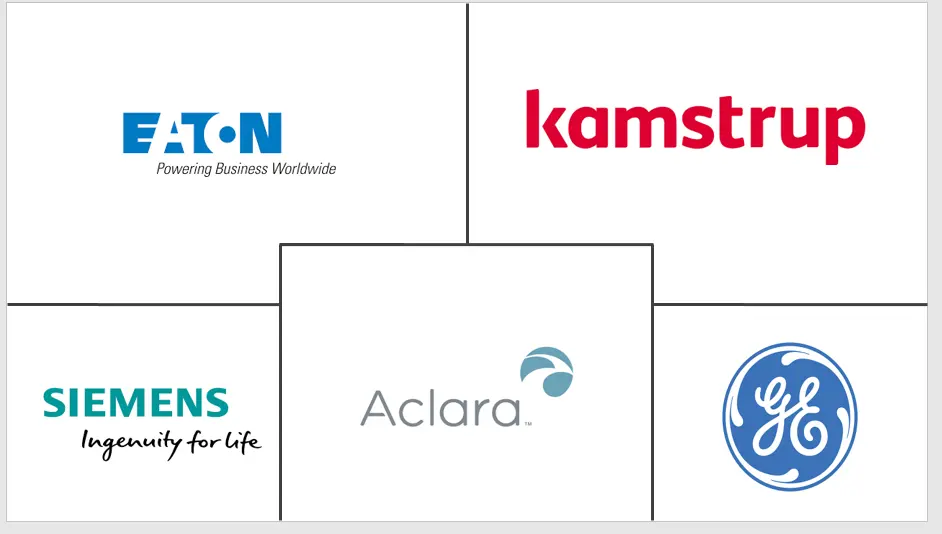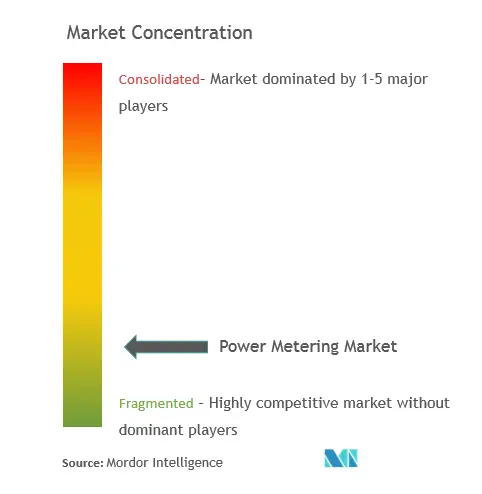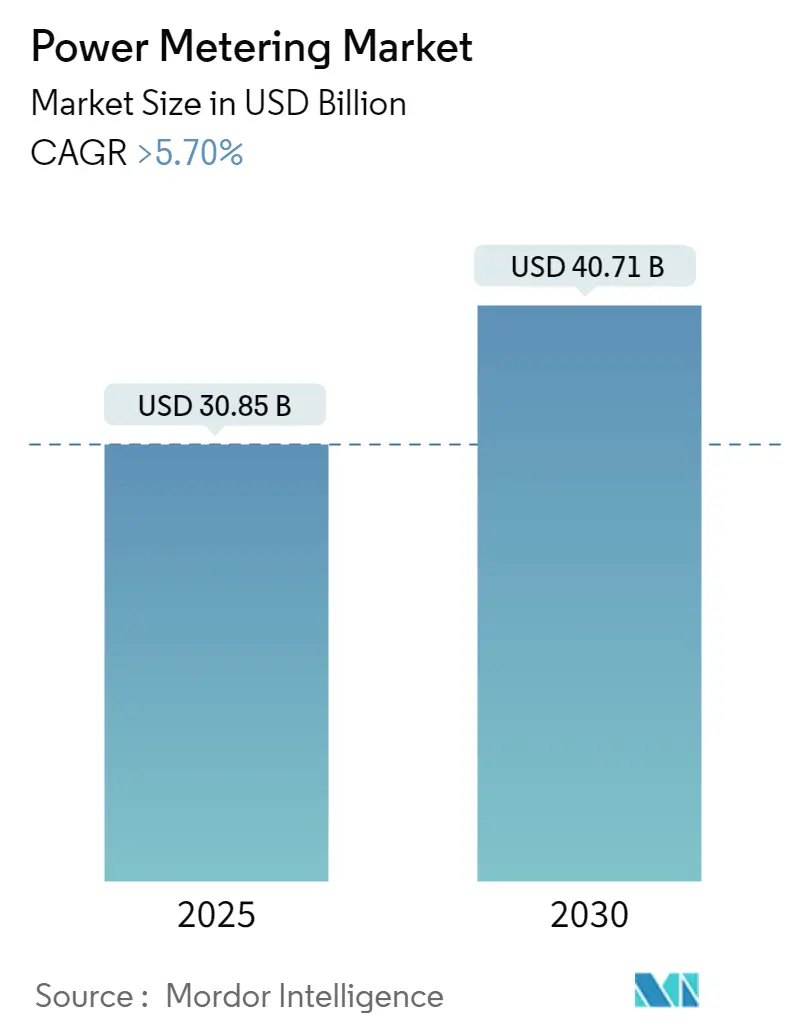
Power Metering Market Analysis
The Power Metering Market size is estimated at USD 30.85 billion in 2025, and is expected to reach USD 40.71 billion by 2030, at a CAGR of greater than 5.7% during the forecast period (2025-2030).
- Over the medium term, factors such as the increasing government focus on developing smart grid infrastructure and the rising investments in deploying smart meters are expected to drive the power metering market.
- However, issues related to privacy and standardization of power meters may restrain the market’s growth during the forecast period.
- Technological advancements and increasing environmental concerns in conventional infrastructure are also expected to open new growth opportunities in the global market.
- Asia-Pacific is expected to dominate the market, with a majority of the demand coming from China and India.
Power Metering Market Trends
Smart Meters Technology is Expected to Dominate the Market during the Forecast Period
- A smart meter is an electronic device that records information about energy consumption more efficiently and effectively. Smart meters provide more detailed energy consumption information to reduce electricity bills and monitor consumption patterns, which are transmitted remotely to the DISCOM company to operate effectively with increasing electricity demand.
- The smart meter market is expected to grow significantly during the forecast period due to supportive government targets and schemes. Several countries are trying to replace old digital or analog meters with smart meters, which is expected to benefit the market’s growth.
- Developed countries like the United States are continuously installing smart meters. According to the Energy Information Administration, in 2022, the United States had about 118 million smart metering infrastructure installations, which accounted for about 72% of total electric meter installations.
- Moreover, according to the Smart Meter Statistics in Great Britain 2023, in 2023, the country had 34.8 million smart meters in homes and small businesses, accounting for 61% of all the meters installed in Britain. In 2023, a total of 3.5 million smart meters were installed. In the same year, other countries, especially in developing regions like Asia-Pacific, also increased the footprint of these meters.
- India has set a target to complete a nationwide smart meter rollout by 2025, aiming to modernize its electricity grid infrastructure and improve energy efficiency. In December 2023, the government sanctioned 222.3 million smart meters for deployment nationwide. By digitizing the electricity distribution system, smart meters can help utilities optimize their operations and enhance overall service delivery to consumers. As per the Smart Meter National Program, the country aims to install 250 million smart meters across the country by 2025.
- In January 2023, the Government of Germany launched a draft law to restart the digitalization of the energy transition and accelerate the installation of smart metering systems. The government set a target of 20% installations by the end of 2025, 50% by the end of 2028, and 95% by the end of 2030 for residential and small business consumers. These installations are expected to provide up to 100,000kWh (and optional for those <6,000kWh) and generators up to 25kW (optionally 1-7kW).
- Companies are actively seeking funding. This expansion requires significant funding, prompting companies to seek financial support from various sources. They are involved in developing smart metering solutions and are actively seeking funding opportunities to support R&D efforts, pilot projects, and large-scale deployments.
- For instance, in December 2023, EDF, also known as Electricité de France, a French government-owned utility services provider, announced its intention to raise USD 100 million to support its smart meter business expansion. Such financial support is expected to boost the presence of smart meter infrastructures.
- Therefore, the adoption of a smart meter in the industrial sector is helping major players in the manufacturing segment optimize energy consumption levels, as a smart meter can facilitate greater control by users over energy usage.
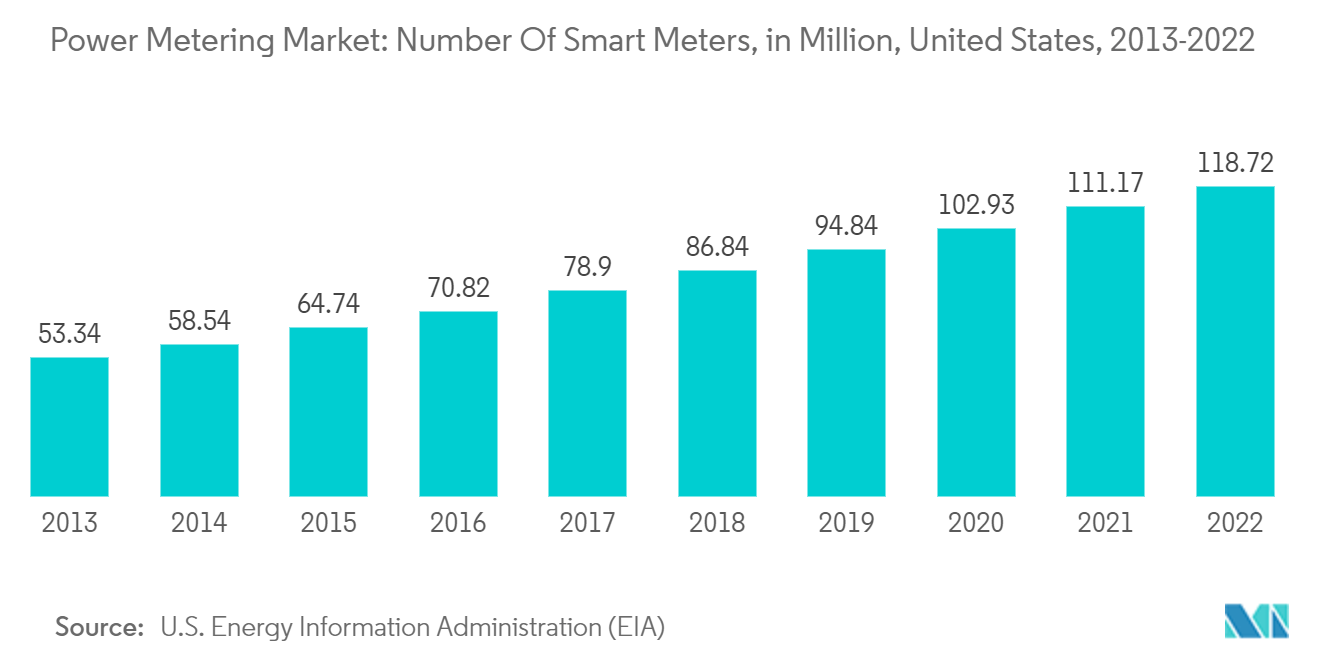
Asia-Pacific to Witness the Highest Growth during the Forecast Period
- Asia-Pacific is expected to be the largest region for power meters due to urbanization in India and China, among other countries. Over the past few years, China has been one of the leaders in deploying power meters due to increasing urbanization and the growing service sector.
- India is investing in developing smart grid infrastructure, which relies on advanced metering technologies such as smart meters, communication networks, and data analytics. Smart grids enable bidirectional communication between utilities and consumers, facilitating real-time monitoring, demand response, and integration of renewable energy sources.
- For instance, in June 2023, the International Finance Corp. (IFC), the World Bank Group's private investment arm, planned to provide USD 500 million (about INR 41 billion) in long-term financing to smart meter makers in India.
- In July 2023, the Indian government set up the National Smart Metering Project, and it plans to install 25 crore meters by 2025 with an estimated investment of USD 30 billion.
- China has invested substantially in smart grid infrastructure, including advanced metering systems, communication networks, and grid management technologies. For instance, in January 2024, China's State Grid Corporation unveiled plans to invest around USD 70 billion in grid network construction for the year. This investment aims to advance ultra-high voltage (UHV) lines, enhance power supply reliability, and increase the utilization of renewable energy sources across China. The State Grid Corporation anticipates completing six UHV AC lines in 2024 and initiating several new UHV projects.
- The demand for smart meters in Japan is driven by several factors that offer real-time monitoring of electricity consumption, empowering consumers to optimize energy usage and reduce costs. The Japanese government's initiatives to improve energy efficiency and integrate clean energy sources have further promoted the adoption of smart meters.
- According to the Ministry of Economy, Trade and Industry, Japanese utilities must install smart meters in all households by March 2025 to improve energy efficiency. The setup of utilities had an initial deadline of 2032 but was forwarded to March 2025 in response to government calls. This will, in turn, create avenues for developing the power metering market.
- Singapore's sovereign wealth fund, GIC, and Genus Power Infrastructures have also agreed to set up a joint venture platform to fund smart metering projects and have committed to investing USD 2 billion in the initial pipeline. Genus plans to scale up the deployment of energy "smart meters" across India, supporting energy security and transition through grid optimization and efficiency.
- The growth rate has scaled up over recent years due to increased construction spending, a rise in industrial activities, and the enhancement of the region's grid infrastructure.
- Therefore, owing to the abovementioned factors, Asia-Pacific is expected to witness the highest growth in the power metering market during the forecast period.
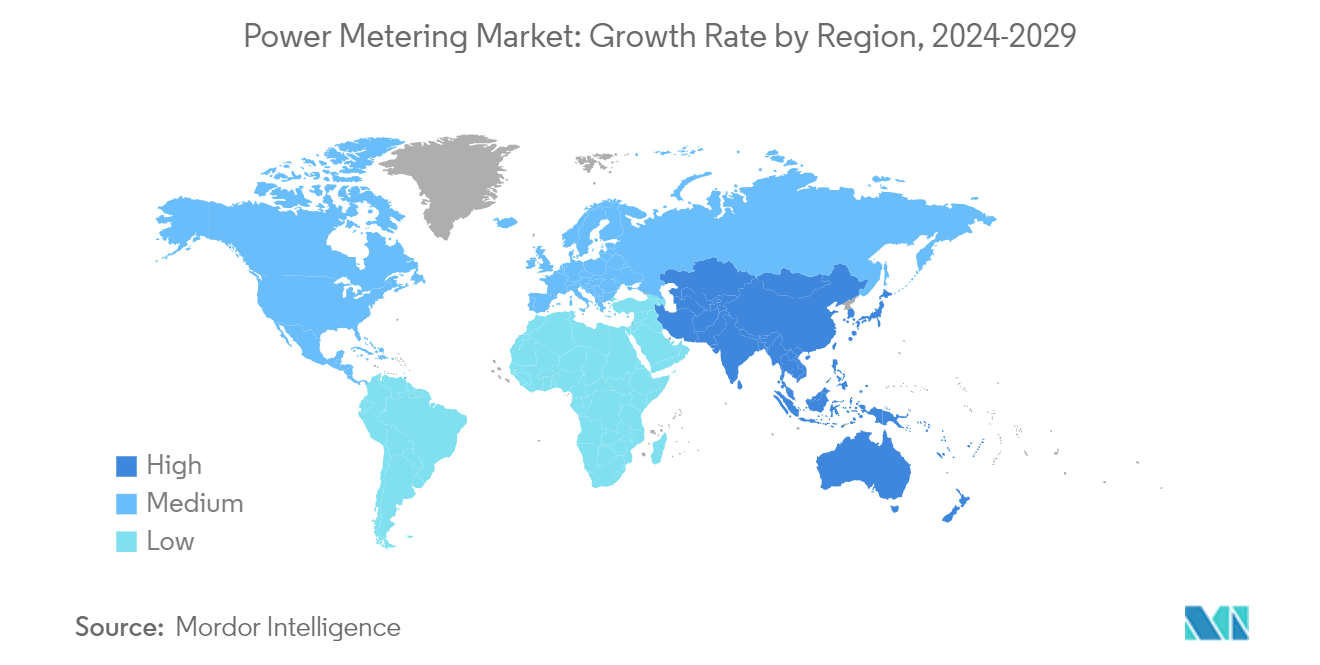
Power Metering Industry Overview
The power metering market is semi-fragmented. Some of the major players in the market include Eaton Corporation PLC, Kamstrup AS, Siemens AG, Aclara Technologies LLC, and General Electric Company.
Power Metering Market Leaders
-
Siemens AG
-
Aclara Technologies LLC
-
General Electric Company
-
Eaton Corporation PLC
-
Kamstrup AS
- *Disclaimer: Major Players sorted in no particular order
Power Metering Market News
- March 2024: The Government of India announced the Smart Meter National Program (SMNP). The program aims to replace 250 million conventional electricity meters with prepaid smart meters, along with upgrading infrastructure such as feeders and transformers. The project will be funded with an estimated capital expenditure of INR 1.5 trillion (approximately USD 17.97 billion) and is slated for implementation over the next five fiscal years.
- February 2024: To support the deployment of smart meters, power regulator Enre issued a resolution establishing a public-private working group tasked with helping drive forward the deployment of the meters in the coverage areas of Buenos Aires distributors Edenor and Edesur. The smart meters, also known as advanced metering infrastructure (AMI), will provide real-time data on energy usage, enhancing energy efficiency and enabling a more sustainable energy landscape.
Power Metering Industry Segmentation
Power metering refers to the process of measuring and monitoring the consumption of electrical energy in a particular system or device. It involves the use of specialized devices, called power meters or energy meters, to measure the amount of electricity consumed accurately.
The power metering market is segmented by end user, technology, and geography. By end user, the market is segmented as residential, commercial, and industrial, and by technology, the market is segmented into analog meters, digital meters, and smart meters. The report also covers the market size and forecasts for the power metering market across major regions. The report offers the market size and forecasts in value for each of the abovementioned segments.
| End User | Residential | ||
| Commercial | |||
| Industrial | |||
| Technology | Analog Meters | ||
| Digital Meters | |||
| Smart Meters | |||
| Geography | North America | United States | |
| Canada | |||
| Rest of North America | |||
| Asia-Pacific | China | ||
| India | |||
| Japan | |||
| South Korea | |||
| Malaysia | |||
| Thailand | |||
| Indonesia | |||
| Vietnam | |||
| Rest of Asia-Pacific | |||
| Europe | Germany | ||
| France | |||
| United Kingdom | |||
| Spain | |||
| Nordic | |||
| Turkey | |||
| Russia | |||
| Rest of Europe | |||
| South America | Brazil | ||
| Argentina | |||
| Colombia | |||
| Rest of South America | |||
| Middle East and Africa | Saudi Arabia | ||
| United Arab Emirates | |||
| Qatar | |||
| South Africa | |||
| Nigeria | |||
| Oman | |||
| Egypt | |||
| Algeria | |||
| Rest of Middle East and Africa | |||
Power Metering Market Research Faqs
How big is the Power Metering Market?
The Power Metering Market size is expected to reach USD 30.85 billion in 2025 and grow at a CAGR of greater than 5.70% to reach USD 40.71 billion by 2030.
What is the current Power Metering Market size?
In 2025, the Power Metering Market size is expected to reach USD 30.85 billion.
Who are the key players in Power Metering Market?
Siemens AG, Aclara Technologies LLC, General Electric Company, Eaton Corporation PLC and Kamstrup AS are the major companies operating in the Power Metering Market.
Which is the fastest growing region in Power Metering Market?
Asia Pacific is estimated to grow at the highest CAGR over the forecast period (2025-2030).
Which region has the biggest share in Power Metering Market?
In 2025, the North America accounts for the largest market share in Power Metering Market.
What years does this Power Metering Market cover, and what was the market size in 2024?
In 2024, the Power Metering Market size was estimated at USD 29.09 billion. The report covers the Power Metering Market historical market size for years: 2019, 2020, 2021, 2022, 2023 and 2024. The report also forecasts the Power Metering Market size for years: 2025, 2026, 2027, 2028, 2029 and 2030.
Our Best Selling Reports
Power Metering Industry Report
Statistics for the 2025 Power Metering market share, size and revenue growth rate, created by Mordor Intelligence™ Industry Reports. Power Metering analysis includes a market forecast outlook for 2025 to 2030 and historical overview. Get a sample of this industry analysis as a free report PDF download.

